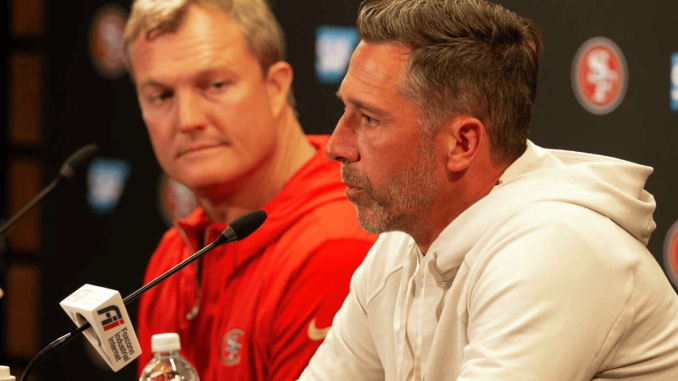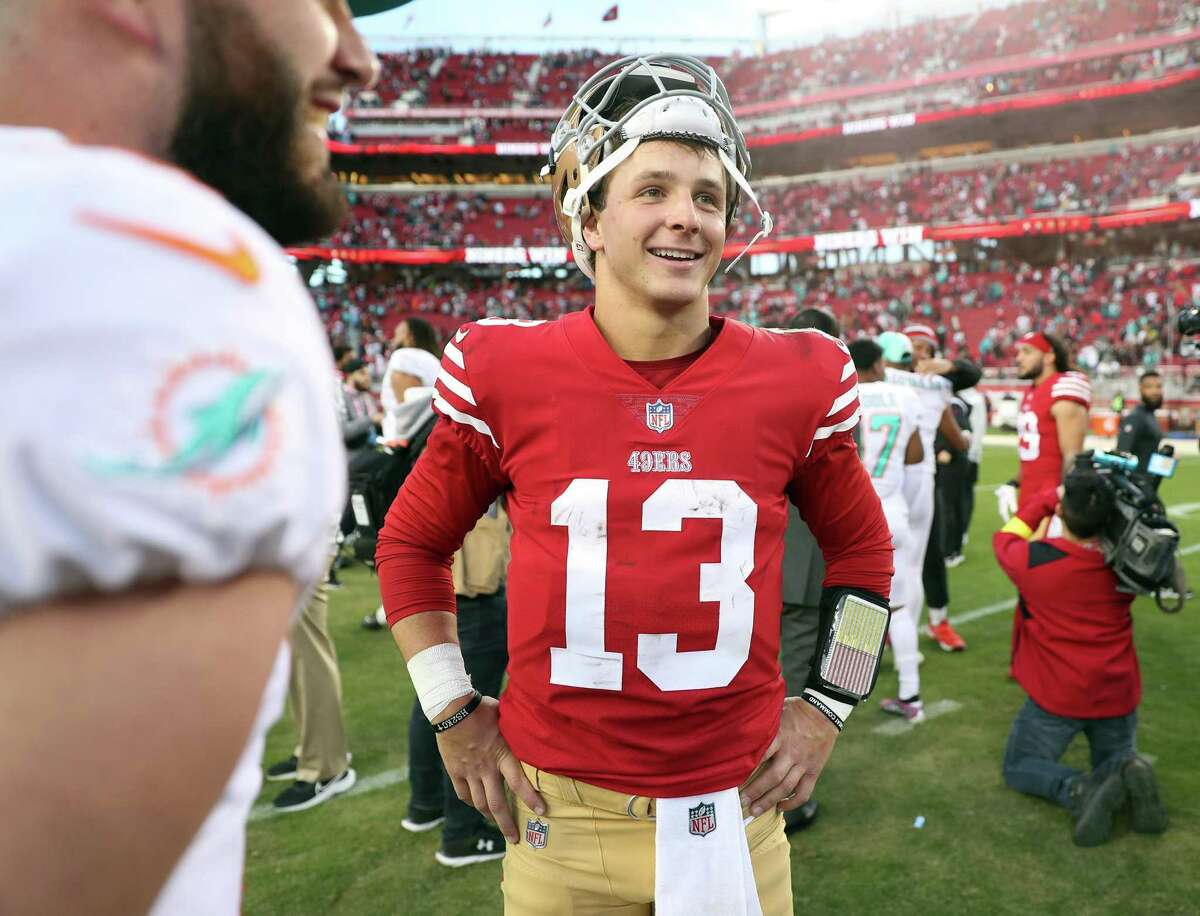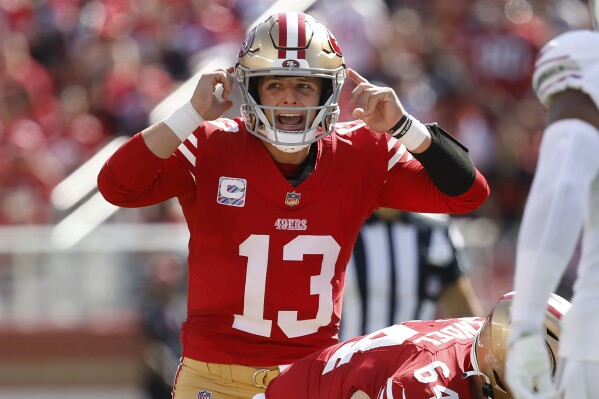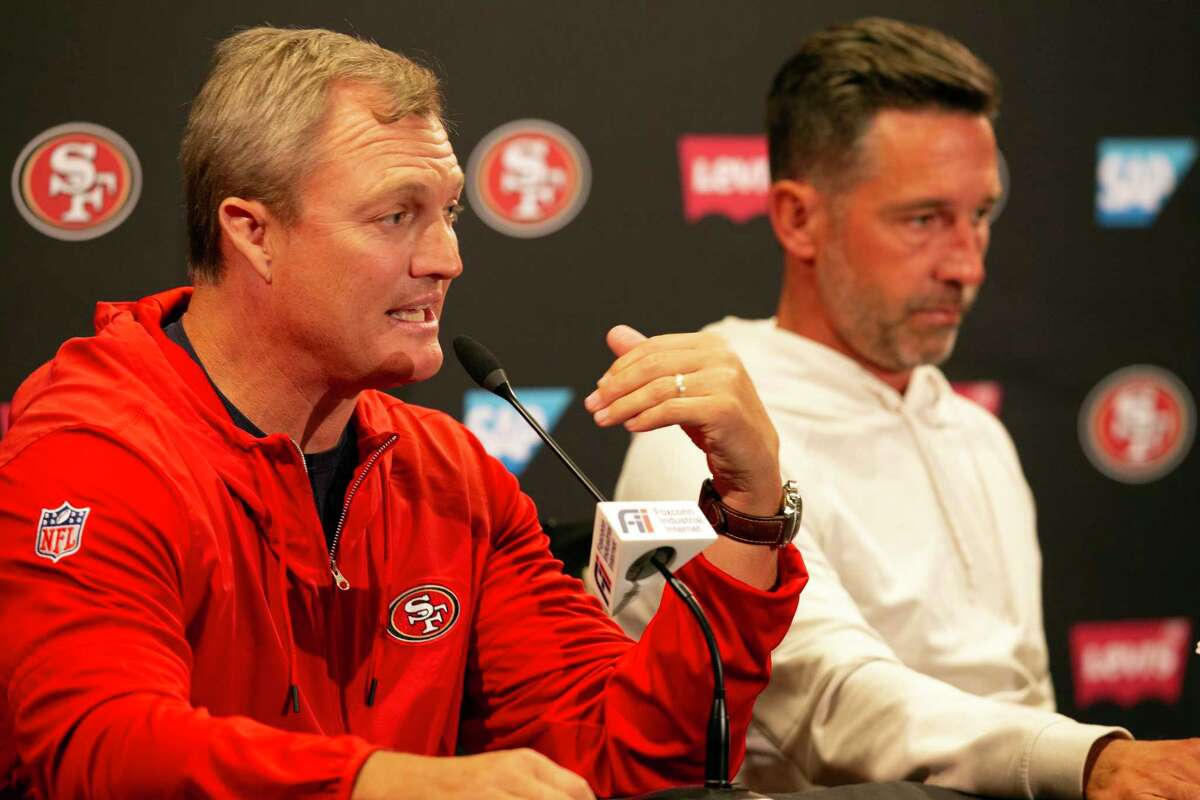
Brock Purdy after 17 NFL starts: Stats, future for 49ers QB

SANTA CLARA, Calif. — It hasn’t quite been a year since Brock Purdy took over as the San Francisco 49ers’ starting quarterback. It has, however, been 17 games, which means Purdy’s sample is no longer small.
Not that Purdy has time to worry about such career benchmarks. That’s why the second-year quarterback was surprised when informed Sunday after San Francisco’s 34-3 win against the Jacksonville Jaguars that he now had a full season’s worth of starts under his belt.
“I didn’t know that,” Purdy told ESPN. “It went quick. That’s crazy to think about.”
Purdy made his first NFL start on Dec. 11, 2022, against the Tampa Bay Buccaneers. Coincidentally, he will start his second cycle through the league Sunday against those same Bucs, whom the 49ers host Sunday at Levi’s Stadium (4:05 p.m. ET, Fox).
Throughout Purdy’s stint as starter, there have been plenty of ups, a few downs, a devastating injury and almost nonstop outside chatter about whether he’s the quarterback who can get the 49ers their sixth Super Bowl title.
Which makes now a great time to look at what’s fact and what’s fiction about the start of Purdy’s career, using five different realities and misconceptions as the 49ers look to their future.
Note: For the purposes of this exercise, we’ve included the relief appearance against Miami in Week 13 last season in which he played about three quarters. Adding that to the less than one quarter he played in the NFC title game makes for a full 17th game.

The 49ers believe Purdy can be their quarterback long term: FACT
Coach Kyle Shanahan and the 49ers have believed in Purdy from the moment he stepped in against the Dolphins to replace an injured Jimmy Garoppolo.
Short of Tom Brady deciding he wanted to extend his career in San Francisco, Purdy was always going to be the Niners’ starter this season so long as he was fully recovered from the torn ulnar collateral ligament in his right elbow he suffered in the NFC Championship Game loss to the Philadelphia Eagles.
Since overcoming that hurdle early in training camp, Purdy has done nothing to lessen Shanahan’s faith in him. Even during the Niners’ recent three-game losing streak in which Purdy threw five interceptions, Shanahan scoffed at the idea of benching his 23-year-old quarterback.
“I love having a guy who isn’t thinking about that,” Shanahan said of Purdy, who has thrown for 2,329 yards and 15 touchdown passes to five interceptions on 172-of-250 passing this season. “He’s trying to make the right decisions, letting it rip, and he’ll live with the consequences and try and get better when it’s not.”
In Purdy’s 17 starts, the Niners have gone 13-4, and he ranks second in the NFL in QBR (72.7), first in yards per attempt (8.9), sixth in completion rate (68.1%), fifth in touchdown passes (31) and third in touchdown-to-interception ratio (3.9).
Whether outside observers choose to believe it, the Niners see Purdy as their quarterback for the short and long
 term.
term.
Purdy throws to only wide-open pass-catchers: FICTION
One of the so-called knocks on Purdy is that he is constantly throwing the ball to teammates with no defenders in the same zip code. While Shanahan’s scheme and a talented group of skill position players make a big difference (more on this in a moment), Purdy’s receivers aren’t necessarily more open than anyone else’s.
NFL Next Gen Stats tracks average separation for receivers at the time of the ball’s arrival. Those numbers can be skewed a bit by a quarterback’s arm strength (or lack thereof), but it’s a good indicator of how open a pass-catcher is when the ball arrives.
On Purdy’s pass attempts, the 49ers average 3.46 yards of separation, which is 17th in the NFL.
Purdy’s tight-window throw percentage is 10.8%, which is third lowest in the NFL, a sign that he isn’t often forcing the ball to someone who isn’t open. For context, Kansas City Chiefs quarterback Patrick Mahomes has the lowest percentage in the league in this category.
Next Gen categorizes wide-open throws as those on which a pass-catcher has 5-plus yards of separation when the ball arrives. Purdy’s 21.3% wide-open percentage ranks 20th in the NFL.
There’s nothing wrong with throwing to open receivers; that’s a top requirement for the job. Purdy does that well, but on the whole his pass-catchers aren’t more open than even half the league’s other signal-callers.

Purdy benefits from one of the best groups of skill-position players and playcallers/designers in the league: FACT
Two things can be true at once, Purdy profits from an excellent scheme and surrounding talent while still doing his part to make it go. At its core, Shanahan’s offense remains a run-first scheme with back Christian McCaffrey as the focal point, which is why Purdy’s 26.3 pass attempts per game is 23rd in the league since he took over as starter.
Purdy also has tight end George Kittle, receivers Deebo Samuel and Brandon Aiyuk, fullback Kyle Juszczyk and left tackle Trent Williams, all of whom are among the best in the league at their positions.
They all play a big role in Purdy ranking second (behind Mahomes) in the NFL in yards after catch per completion (6.24) since he became the starter. What’s more, Purdy’s pass-catchers are averaging 1.64 yards after catch more than expected, which is first in the NFL. The next closest team, the Houston Texans, are at 0.98.
Not that Purdy should apologize for taking advantage of a good situation, but there’s plenty of credit to go around for an offense that is first in offensive expected points added (plus-124.78) since Purdy stepped in.
Purdy needs to take better care of the ball, especially in close-and-late situations: FACT
During the Niners’ three-game losing streak, Purdy had six turnovers, including five interceptions. It was easily the most difficult stretch of his career.
On Sunday, Purdy was asked what has been the single biggest thing he has learned as a starter. He answered with little hesitation.
“Just not being stupid,” Purdy said. “Playing consistent football. If you can make the right decisions consistently over and over and over and not get bored, just take a profit with checkdowns and being smart, I think that allows you to have success as a quarterback. … A full season under my belt, 17 games now, that’s I think the biggest thing.”
The counting stats aren’t bad: Purdy has eight interceptions, tied for 12th fewest in the league among qualifying players, and he has lost just three fumbles. But Purdy also has tended to put the ball in harm’s way.
Pat McAfee explains why he believes the 49ers’ losing streak won’t be talked about again.
Pro Football Focus tracks turnover-worthy plays, which includes fumbles that the offense recovers and interceptable passes that the defense drops. Through nine games this year, Purdy has 14 turnover-worthy plays, sixth most in the NFL, and that comes after he had seven in 10 games in 2022.
Of more concern is that Purdy’s picks have come at the worst possible times. Three have been in the fourth quarter with the Niners trailing and in opponent territory, and six of his eight career interceptions have come in the second half when trailing.
While Purdy has a full season of games now, he still doesn’t have a big sample in attempting to lead comebacks. He was successful in Week 17 last year against the Las Vegas Raiders but was unable to do it during the three-game losing streak (not that Jake Moody missing a tying field goal in Cleveland was his fault). Still, Purdy is aware of his faults and working to get better at winning time.
“One thing about Brock is he always takes accountability of his mistakes and he wants to be the best version of him as possible, and that’s one thing we like about Brock here,” Samuel said.
Purdy not only doesn’t throw deep often but struggles when he does: FICTION
One of the biggest myths about Purdy is that he simply checks the ball down to his pass-catchers and they do all the work with yards after the catch. But the reason Purdy leads the NFL in yards-per-attempt average (8.9) since becoming the 49ers’ starting quarterback is because Purdy is pushing the ball down the field and his teammates are getting yards after the catch.
“I think Purdy has been more successful throwing the ball down the field than anyone that we’ve had since ’17,” Juszczyk said. “You really don’t see a ton of checkdowns because he’s been so successful getting it to that first read down the field.”
That’s not to say Purdy just airs it out, but he has moved the Niners into the middle of the pack in any measure of the deep ball since stepping in. Since he took over as Niners QB, Purdy’s 7.5 air yards per attempt ranks 19th in the league (ahead of Mahomes, Joe Burrow, Trevor Lawrence and others). His 19.25 true air distance per completion is 12th, and 10.5% of his throws travel 20-plus air yards, which is 16th, ahead of many of the biggest names at the position and a major uptick from years past. Niners QBs threw 8.1% of their attempts 20-plus yards from 2017 until Purdy took over, last in the NFL.
More important, Purdy has been good at taking shots down the field. Among qualified QBs, he’s fourth in completion rate (52%), ninth in yards (779), eighth in yards per attempt (15.6), tied for sixth in touchdowns (six) and eighth in QBR (93.2) on throws traveling 20-plus air yards.
Texans able to escape despite Stroud’s uncharacteristic day
Stephen A. Smith is full of praise for C.J. Stroud and weighs in on his MVP candidacy. (1:34)
HOUSTON — Finding ways to overcome adversity has been the theme for the Houston Texans this season.
Whether it was missing four starters on the offensive line against the Pittsburgh Steelers and still capturing a 30-6 win in Week 4 or escaping with a game-winning drive in the last seconds against the Tampa Bay Buccaneers in Week 9, the Texans have dealt with obstacles.
Week 10 against the Cincinnati Bengals was no different.
The Texans pulled out another last-second win, 30-27, after blowing a 10-point lead with under four minutes left in the game. Quarterback C.J. Stroud conducted a game-winning drive with kicker Matt Ammendola drilling a 38-yard field goal in his debut with the team.
“So proud of our guys for finding a way to win,” coach DeMeco Ryans said. “We talked about this on Saturday night, just doing whatever it takes, finish every snap. I told the guys it comes down to the last snap. We still found a way to finish, so I’m really proud of the way our guys fought. I’m proud of the plays that they made to help us win that game. We have to play cleaner, and there were a lot of mistakes that we made to make the game close. There are things we can clean up, and it’s better to clean them up after a win.”
Stroud’s ball security has been among the best this season. Despite throwing for 356 yards and scoring rushing and passing touchdowns, the rookie — who came into the game with only three turnovers (one interception and two fumbles) — had his first multiple-turnover game, as he had an ill-timed interception and two lost fumbles.
The Texans (5-4) only had five turnovers coming into Week 10, but they still found a way to win despite the three Sunday.
“These types of games come down to the last minute,” Stroud said. “It’s hard to win in the NFL. It’s a great Bengals team over there, and they prove it week in and week out. We came in with the mindset that we won’t be denied, and that was huge for us.”
With 3:41 remaining and a 27-17 lead, Stroud was intercepted by Cam Taylor-Britt, who returned it to the Texans’ 4-yard line. The Bengals scored a touchdown two plays later and were able to get down to the Texans’ 7-yard line with 1:53 remaining after a three-and-out by Houston. The Texans were able to hold Cincinnati to a field goal, which set up the game-winning drive.
“No one wavered on our sideline, and that’s what I love,” Ryans said. “I love the resolve of our team. Everyone believed that we were going to win, everyone put in the work and made the plays to help us win this game. It starts with the confidence that you have to have to win these tight games. Also, knowing that we got guys. We have CJ, receivers, and Noah [Brown] stepped up and had a big game. Guys stepped up and made big plays.”
Ryans has enforced a no-excuse mindset in his first season as a head coach and preached finding ways to win no matter the obstacles.
The Texans were without their leading receiver Nico Collins (groin), their leading rusher Dameon Pierce (ankle), down to their fourth-string center and without starting safety Jimmie Ward (hamstring). Kicker Ka’imi Fairbairn was placed on injured reserve Saturday with a quad injury and Ammendola was elevated to the active roster.
The Texans’ two starting cornerbacks, Derek Stingley Jr. (hamstring) and Steven Nelson (neck), were on a pitch count as they worked back from injury.
Still, Brown was able to set a career-high for the second week in a row with just his second 100-yard game since being selected in the seventh round of the 2017 draft by the Dallas Cowboys. He finished with eight catches for 172 yards. And Ammendola was perfect on the day, going 3 for 3 on both field-goal attempts and PATs.
“Matt stepped in and did an unbelievable job for us,” Ryans said. “He’s a veteran kicker who’s been there before and done it before. We’re happy to have him. The confidence that we had in him and his range, he nailed it.”
And then there was Devin Singletary, who was able to give a spark to one of the league’s worst rushing attacks (29th) coming into the week. He became the first Texan to rush for over 100 yards this season with a career-high 150 and scored his first touchdown as a Texan.
“Man, it was a wild wind of emotions on the back end of the game,” Singletary said. “Guys stayed poised. We got a bunch of dogs. All we ever needed was a chance. That’s all we can ask for, and we were able to come out on top.”
The win put the Texans over .500 this late in the season for the first time since 2019, and they are now one game behind the Jacksonville Jaguars (6-3) in the AFC South heading into Sunday’s home matchup against the Arizona Cardinals (1 p.m. ET, NRG Stadium, CBS).
It was all topped by Stroud continuing to push the rookie threshold for a quarterback. His 826 yards the last two games is the second-most ever for a rookie, and he’s already tied for the most games with at least 350 yards passing for a rookie (three) after Sunday. He’s also not just just good for a rookie, as he leads the NFL in passing yards per game with 291.8.
Montez Sweat has invigorated the Chicago Bears defense
The impact felt by defensive end Montez Sweat, who the Bears acquired from the Washington Commanders before the trade deadline on Oct. 31 for a 2024 second-round pick, has been noticeable since he first suited up against the New Orleans Saints in Week 9.
Four days later, in his second game with Chicago — a 16-13 win over the Carolina Panthers — Sweat recorded five quarterback pressures, according to ESPN Stats & Information, which are the most by a Bears defender in a game during the last two seasons.
“Having the effect of ‘Tez, the ‘Tez factor, is a pretty cool thing to see,” Eberflus said. “You could feel him forcing those incomplete passes, the hits on the quarterback.
“That certainly has an effect on their passing game.”
The Bears held the Panthers to 170 yards passing, their lowest output by an opponent this season. Quarterback Bryce Young, who was the No. 1 overall pick in April, was sacked three times and consistently under duress.
Sweat is still looking for his first sack with Chicago, but he found ways into the backfield to disrupt Young by getting past blocks and forcing the quarterback to throw errant passes.
“We wanted to rattle Bryce Young a little bit,” Sweat said postgame. “I think we did a great job of that.”
Entering Week 10, the Bears had the lowest pressure rate in the NFL at 22%. Against the Panthers, Chicago’s defense generated pressure on 32% of Young’s drop backs, its second-highest rate this season.
The Bears traded for Sweat to improve their pass rush after finishing last in the league with 20 sacks last season.
“That factor that we’re talking about will just keep going,” Eberflus said. “I think he’s helping our guys rush.
“We’re rotating our guys a little bit better, keeping our guys fresh. I think that’s going to be important, because you want those rushers in the fourth quarter. The games are always going to be tight, and you want those guys at the end.”
The Bears still own the league’s lowest sack percentage (3.4%), total sacks (13) and are tied with the Saints and Rams with the fourth-fewest quarterback hits (45) through 10 weeks, but the defensive improvements starting with the increased pressure up front is starting to come through on the back end of the defense.
Four Chicago defenders were credited with pass breakups against the Panthers. Two would have been interceptions had they not been dropped.
“I feel like we had tight coverage throughout the duration of the game … allowing the D-linemen to get there,” cornerback Jaylon Johnson said. “They did a heck of a job pressuring, getting sacks.
“I feel like top to bottom, we played a solid game together.”

Against Detroit in Week 11, the test gets stiffer. The Lions boast a top-3 offensive line in pass-blocking efficiency and have allowed the fewest sacks (16). Facing a Chargers defensive line with Joey Bosa and Khalil Mack proved no problem for the Lions, who allowed no sacks and just two quarterback hits.
This is the Bears’ chance to see if the progress they’ve made up front is the byproduct of facing a struggling offense or a sign of real growth that has been sparked by the addition of a game-changer up front — one who is beginning to see how productive his unit can be when they turn hits and hurries into takedowns.
“All hats to the ball,” Sweat said. “‘Flus talks about all the guys getting to the ball. I think we’re going to be a great defense. We’ve just got to start generating some turnovers.”

Leave a Reply